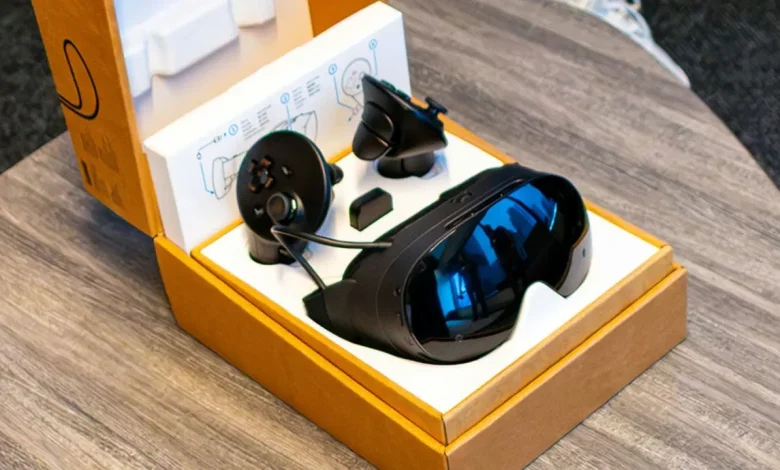Steam Frame Preview – Hands-On With Valve’s State-of-the-Art VR Headset

I know what you’re probably thinking – why put out a new VR headset in 2026? Big hit VR games have been few and far between in recent years, but Valve is convinced that there’s still an appetite for VR, especially if it can make a headset that combines the best of what headsets offer today and innovate in key areas. That’s where the Steam Frame comes in – a successor to the Valve Index that came out in 2019. Along with the new Steam Machine and Steam Controller, I was able to use the upcoming Steam Frame when I visited Valve last month and it is genuinely impressive tech that I wish came around a lot sooner.
I’ll start with a few of the basic tech specs – the Steam Frame can be used as a standalone device like the Meta Quest 3, as it’s powered by a 4nm Snapdragon ARM processor and 16GB of RAM. It’ll be available in 256GB and 1TB UFS storage options, and there’s a microSD slot for expansion. Its pancake optics put out 2160×2160 resolution per eye and can do between 72Hz to 120Hz refresh rate with an experimental 144Hz. And its FOV goes up to 110 degrees. The Steam Frame does inside-out tracking via four outward-facing cameras with IR illuminator for dark environments, and two interior cameras for eye tracking. No need for Lighthouse sensors – external VR sensors are officially a thing of the past.
Steam Frame – Photos
However, the biggest innovation here is in its wireless tethering tech. The Steam Frame comes with a USB receiver that connects the headset to a PC wirelessly through a super low latency 6GHz signal. This lets you wield the power of your PC without cables tying you to it and without any jarring lag that’d make you sick. I tested this myself playing about 15 minutes of Half-Life: Alyx on the Steam Frame and just anecdotally, it ran flawlessly – of course, this was under perfect conditions, but movement tracking, gesturing with the controls, and image quality were all on point, living up to my memory of playing it on the Index via a wired connection when I reviewed the game back in 2020. And with WiFi 7, it’ll work simultaneously when connected to the internet without interference.
Because of the bandwidth and speed afforded by the 6GHz wireless signal, Valve is able to wield a new technique called foveated streaming. With eye tracking, the headset is able to recognize where you’re looking and immediately focus resources there for optimal image quality and highest resolution to the visible area. It’s a similar idea to foveated rendering, where the game itself will dedicate your system’s resources to better handle the load for performance and graphics. But with foveated streaming, it’s happening at the hardware level, so it’s not something developers need to worry about implementing. Either way, it’s key to understand that this is not necessarily affecting core performance – rather it’s to ensure that the wireless feed stays lag-free and looking its best.
Both the freedom of sharp built-in tracking and fast wireless connectivity, along with the power of a proper gaming PC, makes for the ideal VR experience. But that’s not all the Steam Frame excels at. It’s fairly lightweight overall, and its weight distribution makes it feel like a natural extension of yourself rather than a front-loaded brick strapped to your head. Its battery is actually on the rear of the headstrap, so it’s more balanced than other VR headsets, and if you need to plug in, the USB-C port is also on the back so the cable stays out of your way. The padding around the headset is plushy and was comfortable in the short time I used it, and the strap was easily adjustable to get the right fit.
The Steam Frame runs SteamOS natively, so you get the same interface and quality of life features as you would a Steam Deck or upcoming Steam Machine, including the advantage of Proton. But I was surprised by how much I enjoyed the virtual theater experience when using the Steam Frame. Like other VR headsets, you’re able to play non-VR games inside of it through a “fake” TV that SteamOS projects within the headset’s virtual space. And on the Frame, it looked really crisp. I played about 10 minutes of Hades 2 at 4K with the virtual screen blown up to its maximum size, like having a 100-inch TV I didn’t have to buy and fit into my living room. This kind of experience isn’t new, I know, but the seamless integration through SteamOS also makes it very easy to use, and the super fast wireless tech means you can play PC games with the full strength of your system at low latency. I did notice a bit of stuttering at times with the image rendering, similar to screen tearing, but further testing in the future has me curious about how reliable it’s going to be.
Steam Frame VR Headset Specs, at a Glance
- Resolution: 2160×2160 per eye (pancake optics)
- Field of View: 110 degrees
- Refresh Rate: 72Hz to 120Hz (144Hz experiemental)
- Weight: 435g total
- Processor: 4nm Snapdragon ARM
- Memory: 16GB Unified LPDDR5 RAM
- Storage: 256GB / 1TB UFS storage options (microSD slot for expansion)
- Connectivity: Wi-Fi 7, 2×2 Dual 5Ghz/6Ghz streaming for simultaneous VR and Wi-Fi
- Wireless PC Tethering: Wi-Fi 6E (6Ghz) with USB 3.0 receiver
- Tracking: 4x outward facing monochrome cameras (outward IR illuminator for dark environments), 2x interior cameras for eye tracking
- Battery: Rechargeable 21.6 Wh Li-On Battery (mounted on back of headstrap)
While Valve is intending the Steam Frame to be primarily used with the wireless tether for robust VR experiences, the internal hardware is decent enough for certain games. I played the puzzle adventure game Ghost Town, and while it ran smoothly, it was visually a bit muddy, which speaks to the competent but very modest power of the Snapdragon ARM processor. But the ARM compatibility is impressive for running less demanding stuff. To be clear though: Don’t expect Half-Life Alyx to be playable straight off the internals of the Steam Frame.
The new Frame controllers are also an evolution of the excellent Index controllers, including capacitive touch sensors for recognizing hand gestures and the grip of your fingers. The battery slots are placed so as to not get in the way of this, as they need one AA battery each and should last for about 40 hours of use. They feature the TMR magnetic sticks and HD haptics you see on the new Steam Controller, and have all the features you’ve come to expect from a traditional gamepad to create parity across all sorts of games. The Index controllers were bulky, for sure, but I do miss how their strap-pad design latched onto my hands to feel more in-tune with VR. Conversely, the Frame’s use a more standard wrist strap design, which feels less like an extension of my hands, but makes them more versatile as controllers.
VR has remained a niche and perhaps Valve is fine with that so long as it has the go-to piece of hardware for that niche.
Lastly, I should mention the built-in speakers, which sounded solid and are cleverly tucked into the headstrap, as is the integrated microphone. Unlike the Index, they’re not actual off-ear headphones but instead integrated into the headband like the Quest 3, which creates a sort of bubble of sound around your head.
When looking at the big picture, the Frame is one piece of a larger Steam ecosystem that Valve has established and will keep growing. There’s a console-like PC in the Steam Machine, a new state-of-the-art Steam Controller, the very successful Steam Deck handheld, and now a smartly designed VR headset. Valve is furthering its claim in PC gaming with all of these devices hitting market while having SteamOS and Proton mature enough to position itself as a serious platform holder.
Hardware lives or dies by its price, and like the Steam Machine, Valve doesn’t have anything to share quite yet. For reference, a 512GB Meta Quest 3 goes for $500 at regular price as of now, so the Steam Frame will have to at least compete in that range. We’ll know for certain when we get closer to its early 2026 release, and when we find out, you’ll definitely hear it from us first.
But the Frame in particular begs the question of where VR gaming is today and where it might be going in the future. As someone who got in on day one reviewing the original HTC Vive and Oculus Rift back in 2016 and keeping up since then, I’m a little perplexed by the state of VR games – especially with something as technically great as the PlayStation VR2 getting very mild software support. I thought Half-Life: Alyx set a bar so high that others would try to reach with the hope of getting a wave of great new VR games in the process, but such wasn’t really the case. Not to say there aren’t noteworthy games that’ve come out since then; Asgard’s Wrath 2 was one particular game that stretched what I thought was possible. But in the nine years it has hit commercial gaming, VR has remained a niche and perhaps Valve is fine with that so long as it has the go-to piece of hardware for that niche.
For more coverage of Valve’s new hardware, check out our hands-on previews of the Steam Machine and Steam Controller, as well as our interview with Valve about the Steam Frame.




